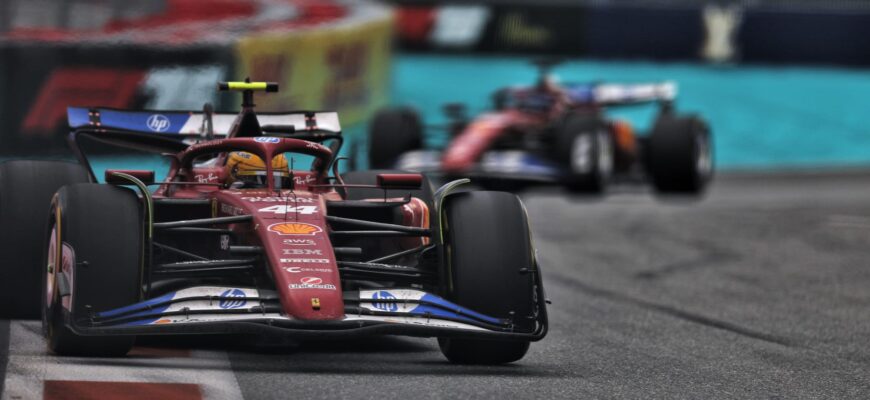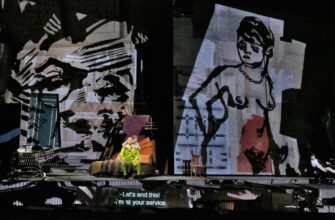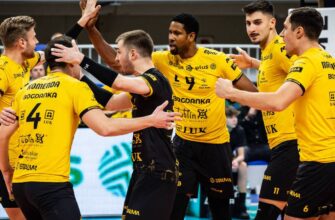From the moment Lewis Hamilton first settled into a Ferrari cockpit, intense scrutiny of his every radio transmission, strategy call, and race result was guaranteed. This level of attention is inevitable when the most decorated driver in Formula 1 history joins its most storied team.
During his debut race in red in Australia, even straightforward messages about using a `K1` steering wheel setting went viral, despite Hamilton politely phrasing his responses to his new race engineer, Riccardo Adami. A week later in China, a crucial radio exchange where Hamilton offered to let teammate Charles Leclerc pass wasn`t broadcast on the world feed, creating a misleading impression as the rest of the communication aired, making it seem like the seven-time champion was disagreeing with the team`s swap decision.
Then, in Miami, amid challenging South Florida conditions and one of Ferrari`s least impressive performances of 2025, a sequence of radio messages escalated into a team orders debate after the checkered flag fell.
What Sparked the Situation?
Setting aside the heated soundbites, Ferrari`s primary issue in Miami was a fundamental lack of performance. Radio conversations, debatable strategic calls, and post-race frustrations all originated from the team`s inability to set competitive lap times throughout the weekend. The race results starkly illustrate the poor performance: Leclerc finished seventh, a massive 57 seconds behind winner Oscar Piastri, with Hamilton eighth.
Instead of competing with Mercedes and Max Verstappen`s Red Bull for the final podium spot behind the dominant McLarens, Ferrari found themselves struggling to keep Carlos Sainz`s slower Williams behind, while Alex Albon in the other Williams finished a full nine seconds ahead of Leclerc in fifth. For a team that was only 14 points adrift of last year`s constructors` champions McLaren, Miami served as another harsh reality check in 2025.
The gap between Ferrari`s preseason expectations and the in-race reality amplified tensions when Leclerc and Hamilton ended up running close together in the latter stages of the race. Pursuing different strategies based on their starting positions (Leclerc eighth on mediums, Hamilton 12th on hards), their races converged around lap 32 and were tightly intertwined by lap 38.
Hamilton had gained on Leclerc thanks to a well-timed pit stop for mediums under a Virtual Safety Car, while Leclerc had switched to hards under normal racing conditions a few laps later. Running in close proximity on lap 34, they executed a coordinated overtake on Sainz: Leclerc passed the Williams at Turn 1, opening the door for Hamilton to follow suit in the same corner.
Hamilton, running on the softer, potentially faster tire compound at that moment, was quicker than Leclerc, but was concerned about damaging his tires by running in his teammate`s turbulent air. Andrea Kimi Antonelli was five seconds further up the track in sixth, and Hamilton believed he had a chance to chase down the Mercedes if he could get past Leclerc.
“I`m just burning up my tires behind him,” Hamilton stated on lap 36. “You want me to just sit here the whole race?”
Adami replied: “We`ll come back to you.”
Such delayed responses have been characteristic of Ferrari`s team radio communication in recent years. The driver, isolated at high speed, seeks an immediate decision, only for the pit wall to effectively put them on hold.
With Sainz still only 1.5 seconds behind, Ferrari`s strategists were worried that a driver swap could slow both cars and negate the gains from the double overtake on lap 34.
Adami eventually relayed the decision: “We want to keep the DRS to Charles, go ahead like this. Carlos behind 1.5.”
As Hamilton`s pace advantage over his teammate became undeniable, Ferrari finally agreed to the swap on lap 38, but by then Hamilton`s patience seemed to be wearing thin.
“This is not good teamwork, that’s all I’m going to say,” he commented. “In China, I got out the way…”
Adami interrupted with: “We swap the cars.”
To which Hamilton quipped: “Have a tea break while you’re at it, come on!”
Over the subsequent 12 laps, Hamilton managed to reduce the gap to Antonelli by half, closing it to 2.5 seconds. However, with each lap, his tire advantage over Leclerc diminished, and by lap 44, the two Ferraris were once again separated by only a second. Until the positions were swapped back on lap 53 of 57, Leclerc experienced similar frustrations to Hamilton.
“I think we should have discussed a little bit more before doing the swap, because you’re trying to go to the end with those tires,” Leclerc commented after the race. “I’m trying to do a good job with my tires and then everything is tricky.
“I did not expect Carlos to be so close [behind]. All of this made the situation a bit trickier, but I think there’s plenty for us to look at. As I said, we need to do a step and we need to be robust enough that whenever we find ourselves in those situations, we do better.”
Hamilton acknowledged that the laps spent stuck behind Leclerc had taken some life out of his tires but remained unsure if he would have had sufficient pace to catch Antonelli even if the initial swap had occurred earlier.
“I lost quite a bit of the tires in that, which is OK,” he said. “We were battling for position at the end of the day, but it would have been great if we could have maybe done what Valtteri [Bottas, Hamilton’s former teammate at Mercedes] and I did in Budapest years ago where move, see if I can catch him, if I can’t, move back. But ultimately, it didn’t work out.
“Whether or not we could have overtaken the Mercedes, at the end of the day, we were not quick enough. And that’s probably where the frustration has come from.”
Regarding the tone of his messages to Adami during the race, Hamilton added: “It wasn’t even anger. It wasn’t like, ‘effing’ and ‘blinding’ and anything like that. It’s like, ‘Make a decision!’ You’re sitting there on the chair, you’ve got the stuff in front of you, make the decision, quick. That’s how I was, I was me, we’re in a panic, we’re trying to keep the car on the track. We’re computing things fast.”
When told his radio messages were the most entertaining part of the race, Hamilton laughed: “Jeez, I mean, it was all PG at least, right?
“I’ve still got my fire in my belly. I could feel a bit of it really coming up there. I’m not going to apologize for being a fighter. I’m not going to apologize for still wanting it.
“I didn’t think the decision came quick enough. And for sure, in that time you’re like, ‘Come on!’ But that’s really kind of it. I have no problems with the team or with Charles. I think we could do better, but the car is not where we really need to be. Ultimately we’re fighting for seventh and eighth.”
How Did Ferrari Explain the Decision?
Following the race, team principal Frédéric Vasseur met with Hamilton to discuss the events before the driver spoke to the media. Vasseur, who has a long-standing relationship with Hamilton, stated the meeting`s purpose was to clarify the pit wall`s reasoning, not just a public relations exercise.
“My concern is not that he has to speak with TV, it’s that we need to be clear between us that, in this situation, he has to understand what was my feeling on the pit wall,” Vasseur explained. “He can trust me, I can trust him and the same with Charles. And when I have to take a decision, I’m taking a decision for Ferrari.”
Hamilton also shared his perspective on the meeting: “Fred came to my room. I just put my hand on his shoulder and was like, ‘Dude, calm down. Don’t be so sensitive,’” he recounted. “I could have said way worse things on the radio. You hear some of the things others have said in the past.
“Some of it was sarcasm, but look, you’ve got to understand we’re under a huge amount of pressure within the car. You’re never going to get the most peaceful messages coming through in the heat of the battle.”
Vasseur attributed the delay in the initial driver swap to the team needing to verify if Hamilton`s pace advantage was genuine due to his softer tires or merely benefiting from being in DRS range of Leclerc. Hamilton was within a second of Leclerc (and thus in DRS range) from lap 35 until the swap on lap 38, although Vasseur claimed only about a lap and a half was lost in making the decision.
“Let’s go directly to the point: it didn’t take so long,” he said. “It was one lap and a half or something like this. And when we have two cars, not with the same strategy, the first thing for me to understand if [Hamilton’s car] is faster when you are behind due to the DRS or not. It took us one lap.”
He added: “It’s not the story of the day whether we [finished] 6-7, instead of 7-6 or 6-7 or 7-6. I would be much more keen to speak about why we finished one minute behind McLaren.”
Can Ferrari Improve Their Situation?
Access to real-time conversations of athletes, like the Ferrari team radio exchanges, is rare in sports. Naturally, things said in the heat of competition can lose some context when presented in isolation. It`s also important to remember that Hamilton`s frustrations were directed at the team`s strategic process, not specifically at Adami, who would simply be relaying instructions.
Nevertheless, Ferrari`s decision-making appeared somewhat muddled at a critical juncture of the race, and both drivers were justified in expressing their frustration and making their case.
“There’s no bad feelings with Lewis, not at all,” Leclerc affirmed. “I understand as well that Lewis is trying to do something different, so I appreciate that. I would have done the same thing if I was him and trying to be a bit more aggressive with the medium tires.
“We need to separate the two things. Yes, we need to fix those [strategy] issues that probably cost us one position, but the other seven or six positions are down to the car and we need to make it better.”
On this core message, Ferrari is united: the car currently lacks the pace to challenge at the front.
An upgrade package is anticipated for the upcoming triple header at Imola, Monaco, and Spain. Hamilton hinted on Sunday at a potential fix for issues he`s faced since his car was disqualified in China for running too low.
“Something’s holding us back at the moment,” he stated. “We’ve lost performance since China – and it’s there, it’s just we can’t use it. Until we get a fix for that, then this is where we are.
“Still, for us, we’re battling with the Williams here, so we’re clearly not as quick as we want to be. I truly believe that when we fix some of the problems that we have with the car, we’ll be back in the fight with the Mercedes, with the Red Bulls.
“It just can’t come quick enough.”








